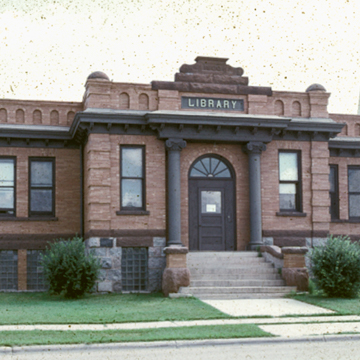You are here
Mayville Public Library (Grandin Brothers Library)
The Mayville Public Library was the gift of two Pennsylvania brothers who, in the 1870s, acquired seventy-five thousand acres of government land grants in the Red River Valley in exchange for bonds of the bankrupt Northern Pacific Railway. In 1878, the Grandin brothers introduced bonanza wheat farming (large-scale, mechanized, investor farms) on their holdings around Mayville. The brothers initially donated $5,000 for a library for Mayville, but contributed an additional $3,000 when the architect advised that a minimum of $6,700 would be required to build his design. This was the first of Albrant’s three library designs—Mayville, Valley City (1902), and NDSU (CS41.2). The foundation, water table, basement window lintels, and main floor sills are of rusticated sandstone. Composite columns flank the door and support an architrave, and a bracketed cornice wraps the entire building. Architectural elements (columns, architrave, brackets, and cornice moldings) are made of wood, painted gray. The texture of the russet-colored brick walls is enriched by emphatic quoins on pilaster shafts and flat arches over the windows. Above the cornice line the word “Library” is centered over the entrance, and date blocks with volutes are mounted in the parapet on the principal elevations. Originally the roof terminated in a dome, but because of leakage problems, the superstructure of the dome was removed in 1933. The library remains in use and is an anchor for other historic architectural buildings in Mayville.
Writing Credits
If SAH Archipedia has been useful to you, please consider supporting it.
SAH Archipedia tells the story of the United States through its buildings, landscapes, and cities. This freely available resource empowers the public with authoritative knowledge that deepens their understanding and appreciation of the built environment. But the Society of Architectural Historians, which created SAH Archipedia with University of Virginia Press, needs your support to maintain the high-caliber research, writing, photography, cartography, editing, design, and programming that make SAH Archipedia a trusted online resource available to all who value the history of place, heritage tourism, and learning.















